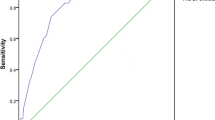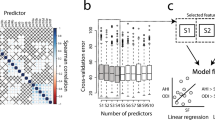Abstract
Purpose
This study evaluated the role of the Pediatric Sleep Questionnaire (PSQ) and associated subscales in predicting the severity of obstructive sleep apnea (OSA) in children referred for attended polysomnography (PSG).
Methods
This is a retrospective study of children (0–18 years) who completed PSQs the night of their initial diagnostic PSG (2019–2020). We excluded children with previous PSG, positive airway pressure titrations, or underlying genetic or craniofacial syndromes. Area under the receiver operating characteristic curve (AUC [95%CIs]) were estimated for prediction of varying severities of obstructive apnea–hypopnea index (oAHI > 2, 5, 10, and 25/h) by the PSQ’s sleep-related breathing disorders (SRBD) scale and subscales.
Results
Of 477 children, median (IQR) age at PSG was 5.7 (4.3); 60% of children were male, 21% were obese, and 4% had oAHI > 25/h. SRBD score did not improve discrimination of OSA cases at any oAHI threshold, with AUC CI that crossed 50% at all severities. Snoring subscale scores were predictive at oAHI > 2/h (AUC = 64.5% [59.5–69.5%]), oAHI > 5/h (AUC = 64.3% [59.6–69.0%]), and oAHI > 10 (AUC = 67.2% [62.0–72.4%]) thresholds, but were not predictive at oAHI > 25/h. The addition of demographic data (age and gender) improved the classification of the SRBD scale.
Conclusions
When utilized in children referred for attended PSG due to concerns for an underlying sleep disorder, the PSQ snoring subscale was more predictive of OSA at varying thresholds than the SRBD scale. While the original intent of the PSQ was not for the purpose of predicting severity in children referred for PSG, future directions include augmenting the questionnaire with additional clinical variables.

Similar content being viewed by others
Data availability
The data that support the findings of this study are available on request from the corresponding author [MB]. The data are not publicly available due to restrictions from the Kaiser Permanente Division of Research.
Abbreviations
- AHI:
-
Apnea–hypopnea index
- oAHI:
-
Obstructive apnea–hypopnea index
- OSA:
-
Obstructive sleep apnea
- PSG:
-
Polysomnogram
- PSQ:
-
Pediatric Sleep Questionnaire
- SRBD:
-
Sleep-related breathing disorder
References
Lumeng JC, Chervin RD (2008) Epidemiology of pediatric obstructive sleep apnea. Proc Am Thorac Soc 5(2):242–252. https://doi.org/10.1513/pats.200708-135MG
Rosen CL, Storfer-Isser A, Taylor HG, Kirchner HL, Emancipator JL, Redline S (2004) Increased behavioral morbidity in school-aged children with sleep-disordered breathing. Pediatrics 114(6):1640–1648. https://doi.org/10.1542/peds.2004-0103
Chervin RD, Archbold KH, Dillon JE, Panahi P, Pituch KJ, Dahl RE, Guilleminault C (2002) Inattention, hyperactivity, and symptoms of sleep-disordered breathing. Pediatrics. 109(3):449–456. https://doi.org/10.1542/peds.109.3.449
Gozal D (1998) Sleep-disordered breathing and school performance in children. Pediatrics 102(3 Pt 1):616–620. https://doi.org/10.1542/peds.102.3.616
Amin RS et al (2005) Left ventricular function in children with sleep-disordered breathing. Am J Cardiol 95(6):801–804. https://doi.org/10.1016/j.amjcard.2004.11.044
Kelly A, Dougherty S, Cucchiara A, Marcus CL, Brooks LJ (2010) Catecholamines, adiponectin, and insulin resistance as measured by HOMA in children with obstructive sleep apnea. Sleep 33(9):1185–1191. https://doi.org/10.1093/sleep/33.9.1185
Koren D, Gozal D, Bhattacharjee R, Philby MF, Kheirandish-Gozal L (2016) Impact of adenotonsillectomy on insulin resistance and lipoprotein profile in nonobese and obese children. Chest 149(4):999–1010. https://doi.org/10.1378/chest.15-1543
Leung LC et al (2006) Twenty-four-hour ambulatory BP in snoring children with obstructive sleep apnea syndrome. Chest 130(4):1009–1017. https://doi.org/10.1378/chest.130.4.1009
Vlahandonis A et al (2014) Long-term changes in blood pressure control in elementary school-aged children with sleep-disordered breathing. Sleep Med 15(1):83–90. https://doi.org/10.1016/j.sleep.2013.09.011
Waters KA et al (2007) Structural equation modeling of sleep apnea, inflammation, and metabolic dysfunction in children. J Sleep Res 16(4):388–395. https://doi.org/10.1111/j.1365-2869.2007.00614.x
Reuveni H, Simon T, Tal A, Elhayany A, Tarasiuk A (2002) Health care services utilization in children with obstructive sleep apnea syndrome. Pediatrics. 110(1 Pt 1):68–72. https://doi.org/10.1542/peds.110.1.68
Tarasiuk A, Simon T, Tal A, Reuveni H (2004) Adenotonsillectomy in children with obstructive sleep apnea syndrome reduces health care utilization. Pediatrics 113(2):351–356. https://doi.org/10.1542/peds.113.2.351
Marcus CL et al (2012) Diagnosis and management of childhood obstructive sleep apnea syndrome. Pediatrics 130(3):576–584. https://doi.org/10.1542/peds.2012-1671
Sateia MJ (2014) International classification of sleep disorders - Third Edition. Chest 146(5):1387–1394. https://doi.org/10.1378/chest.14-0970
Chervin RD, Hedger K, Dillon JE, Pituch KJ (2000) Pediatric sleep questionnaire (PSQ): validity and reliability of scales for sleep-disordered breathing, snoring, sleepiness, and behavioral problems, (in eng). Sleep Med 1(1):21–32
Chervin RD et al (2007) Pediatric sleep questionnaire: prediction of sleep apnea and outcomes, (in eng). Arch Otolaryngol Head Neck Surg 133(3):216–22. https://doi.org/10.1001/archotol.133.3.216
Berry RB, Quan SF, Abreu AR, Bibbs ML, DelRosso L, Harding SM (2020) The AASM manual for the scoring of sleep and associated events: rules, terminology and technical specifications, version 2.6, American Academy of Sleep Medicine, Darien, Illinois, 2020. http://www.aasmnet.org/scoringmanual
Carpenter J, Bithell J (2000) Bootstrap confidence intervals: when, which, what? A practical guide for medical statisticians. Stat Med 19(9):1141–1164. https://doi.org/10.1002/(sici)1097-0258(20000515)19:9%3c1141::aid-sim479%3e3.0.co;2-f
Melendres CS, Lutz JM, Rubin ED, Marcus CL (2004) Daytime sleepiness and hyperactivity in children with suspected sleep-disordered breathing. Pediatrics 114(3):768–775
Parenti SI, Fiordelli A, Bartolucci ML, Martina S, D’Antò V, Alessandri-Bonetti G (2021) Diagnostic accuracy of screening questionnaires for obstructive sleep apnea in children: a systematic review and meta-analysis, Sleep Med Rev :101464
Ferry AM, Wright AE, Ohlstein JF, Khoo K, Pine HS (2020) Efficacy of a Pediatric Sleep Questionnaire for the diagnosis of obstructive sleep apnea in children, (in eng). Cureus 12(12):e12244. https://doi.org/10.7759/cureus.12244
Certal V, Catumbela E, Winck JC, Azevedo I, Teixeira-Pinto A, Costa-Pereira A (2012) Clinical assessment of pediatric obstructive sleep apnea: a systematic review and meta-analysis. Laryngoscope 122(9):2105–2114
Katz SL et al (2014) Paediatric sleep resources in Canada: the scope of the problem. Paediatr Child Health 19(7):367–372
Acknowledgements
We would like to thank the staff of the Kaiser Permanente Martinez Sleep Lab, as well as the patients and families we had the privilege of caring for. We would also like to thank Adam Boroian for assisting with manuscript submission.
Funding
This study was funded by The Permanente Medical Group Division of Research, Delivery Science Grant.
Author information
Authors and Affiliations
Corresponding author
Ethics declarations
Ethics approval
This retrospective study was approved with a waiver of informed consent by the Kaiser Permanente Northern California Institutional Review Board.
Conflict of interest
The authors have no relevant financial or non-financial interests to disclose.
Additional information
Publisher's note
Springer Nature remains neutral with regard to jurisdictional claims in published maps and institutional affiliations.
All authors have seen and approved this manuscript.
Brief Summary
Current Knowledge/Study Rationale: Questionnaire responses have demonstrated variable predictive values for the identification of obstructive sleep apnea in children. We aim to assess the predictive value of the Pediatric Sleep Questionnaire and subscales among children referred for attended polysomnography.
Study Impact: Our study demonstrates that snoring subscales are the most predictive of the PSQ subscales across all severities. It also highlights the need to explore augmentation of questionnaire responses with other variables to improve the predictive value in this population.
Supplementary Information
Below is the link to the electronic supplementary material.
Rights and permissions
About this article
Cite this article
Bseikri, M., Zhang, J., Kirley, J. et al. Predicting obstructive sleep apnea severity in children referred for polysomnography: use of the Pediatric Sleep Questionnaire and Subscales. Sleep Breath 27, 545–552 (2023). https://doi.org/10.1007/s11325-022-02647-6
Received:
Revised:
Accepted:
Published:
Issue Date:
DOI: https://doi.org/10.1007/s11325-022-02647-6




